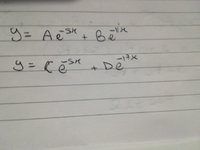SerClaudio
New member
- Joined
- Feb 26, 2019
- Messages
- 5
Could you please help me solve this question?
Solve the two differential equations:
. . . . .[math]\dfrac{d^2y}{dx^2}\, +\, 16\, \dfrac{dy}{dx}\, +\, 55y\, =\, 0[/math]
. . . . .[math]\dfrac{d^2y}{dx^2}\, +\, 22\, \dfrac{dy}{dx}\, +\, 85y\, =\, 0[/math]
...subject to [math]y(0)\, =\, 14.[/math]
Thank you
Solve the two differential equations:
. . . . .[math]\dfrac{d^2y}{dx^2}\, +\, 16\, \dfrac{dy}{dx}\, +\, 55y\, =\, 0[/math]
. . . . .[math]\dfrac{d^2y}{dx^2}\, +\, 22\, \dfrac{dy}{dx}\, +\, 85y\, =\, 0[/math]
...subject to [math]y(0)\, =\, 14.[/math]
Thank you
Attachments
Last edited by a moderator:


